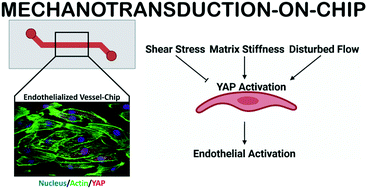Mechanotransduction-on-chip: vessel-chip model of endothelial YAP mechanobiology reveals matrix stiffness impedes shear response†
Abstract
Endothelial mechanobiology is a key consideration in the progression of vascular dysfunction, including atherosclerosis. However mechanistic connections between the clinically associated physical stimuli, vessel stiffness and shear stress, and how they interact to modulate plaque progression remain incompletely characterized. Vessel-chip systems are excellent candidates for modeling vascular mechanobiology as they may be engineered from the ground up, guided by the mechanical parameters present in human arteries and veins, to recapitulate key features of the vasculature. Here, we report extensive validation of a vessel-chip model of endothelial yes-associated protein (YAP) mechanobiology, a protein sensitive to both matrix stiffness and shearing forces and, importantly, implicated in atherosclerotic progression. Our model captures the established endothelial mechanoresponse, with endothelial alignment, elongation, reduction of adhesion molecules, and YAP cytoplasmic retention under high laminar shear. Conversely, we observed disturbed morphology, inflammation, and nuclear partitioning under low, high, and high oscillatory shear. Examining targets of YAP transcriptional co-activation, connective tissue growth factor (CTGF) is strongly downregulated by high laminar shear, whereas it is strongly upregulated by low shear or oscillatory flow. Ankyrin repeat domain 1 (ANKRD1) is only upregulated by high oscillatory shear. Verteporfin inhibition of YAP reduced the expression of CTGF but did not affect ANKRD1. Lastly, substrate stiffness modulated the endothelial shear mechanoresponse. Under high shear, softer substrates showed the lowest nuclear localization of YAP whereas stiffer substrates increased nuclear localization. Low shear strongly increased nuclear localization of YAP across stiffnesses. Together, we have validated a model of endothelial mechanobiology and describe a clinically relevant biological connection between matrix stiffness, shear stress, and endothelial activation via YAP mechanobiology.

- This article is part of the themed collection: Organ-, body- and disease-on-a-chip systems


 Please wait while we load your content...
Please wait while we load your content...
